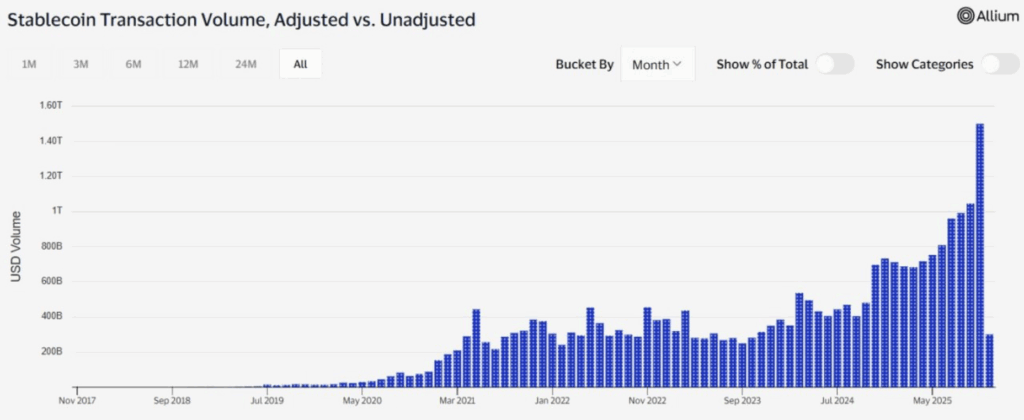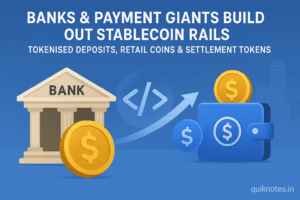Banks, payment-networks and fintech firms are accelerating efforts to build “stablecoin rails” — namely tokenised deposits, retail-facing stablecoins and settlement-tokens designed for 24/7 programmable payments and cross-border flows. The momentum comes amid new regulatory clarity (notably the GENIUS Act) that “cleared the path” for financial-institutions to participate. Several pilots are now live or ramping up globally.
Key facts
- According to a recent McKinsey report, effecting tokenised bank-deposits and bank-backed private stablecoins can enable real-time settlement and friction reduction in payments infrastructure.
- A blog by Fireblocks details how banks are embedding tokenised deposits and stablecoins into corporate collection workflows—allowing instant receipt of funds across jurisdictions and 24/7 settlement.
- The GENIUS Act in the U.S. introduced a federal regulatory framework for payment-stablecoins, clarifying issuer roles, reserve backing and licensing paths.
- In the UK, major banks have begun a live pilot of tokenised sterling deposits, with the report indicating rollout through mid-2026.
- Industry commentary emphasises that beyond pure stablecoins, banks may gain more by focusing on tokenised deposits—bank deposits converted into token form on chain, preserving deposit backing while enabling programmable rails.

Why it matters
- Payment network innovation: Stablecoins and tokenised deposits offer the promise of near-instant settlement, 24/7 transaction capability, programmable features (like conditional payments), and lower cross-border friction compared to legacy rails (SWIFT, card networks). For banks and payments firms this is a strategic imperative.
- Institutional inclusion of crypto rails: As banks and payment giants embrace tokenised rails, the line between traditional finance (TradFi) and crypto infrastructure continues to blur. These rails may underpin treasury operations, merchant payments, cross-border flows and settlement services.
- Regulatory tailwinds: With frameworks like the GENIUS Act clarifying how payment-stablecoins can be issued and regulated, the risk of regulatory arbitrage or uncertainty drops, making pilots and product launches more feasible.
- Competitive pressure: Fintechs, Big Tech and non-bank payment providers have long pushed digital-asset rails. Banks must respond to avoid being sidelined—offering tokenised deposit rails is part of staying competitive in a digital-asset world.
- Infrastructure transformation: Tokenisation of money (bank deposits, fiat-backed tokens) is emerging as a foundational infrastructure shift — moving money, assets and settlement into programmable, chain-native formats. As the BIS notes, tokenised platform rails with commercial bank money + CB-reserves could form the next-gen financial system.
Examples & Developments
- JPMorgan Chase CEO Jamie Dimon indicated the bank is getting “more involved in stablecoins”—including its deposit-coin (JPMD) and stablecoin-related initiatives.
- Citigroup CEO Jane Fraser said Citigroup is active in the tokenised deposit space and is considering issuing its own stable-coin.
- Under UK pilots, banks are exploring tokenised sterling deposits as a step toward programmable payments and on-chain rails.
Challenges & Risks
- Regulatory & compliance burden: Despite clearer frameworks like GENIUS, issuers and banks must meet high standards (reserve backing, transparency, AML/KYC) to avoid systemic risk.
- Operational integration and legacy system drag: Moving deposit rails into tokenised formats and integrating with existing banking architecture is complex, requiring alignment of technology, risk, custody and settlement layers.
- Liquidity & reserve risk: Tokenised deposit rails require commercial-bank deposits, backing assets, and liquidity management; missteps could affect deposit stability or issuer credibility.
- Fragmentation risk: Without standardisation, multiple rails and tokens could cause fragmentation—duplicating infrastructure rather than unifying it, reducing network effects.
- Trust & adoption: Banks and corporates must convince customers and counterparties to adopt tokenised rails over tried-and-tested traditional rails; use-cases must be compelling (faster, cheaper, global).
What to Watch
- Pilot outcomes and live-rollouts — which banks or payments firms go live with tokenised deposit or stablecoin rails, in which jurisdictions, and with what volumes.
- Regulatory rule-making under GENIUS — how quickly regulators publish final rules, what requirements are placed on issuers, and how banks respond.
- Interoperability & standards — whether tokenised deposit/stablecoin rails will interoperate across banks, ecosystems and chains, or remain siloed.
- Adoption metrics — how corporates and merchants adopt tokenised rails for payments, collections, treasury; what cost/settlement metrics emerge.
- Competitive responses — how legacy payment networks (cards, banks) respond, how fintechs and Big Tech factor in, and whether tokenised rails displace part of traditional payment flows.
Bottom Line
Stablecoins, tokenised deposits and programmable payment rails are rapidly moving from concept to real-world implementation — led by banks, payment giants and regulated issuers. The passage of the GENIUS Act and live pilots signal that the “rails of the future” are being constructed now. For financial institutions, the stakes are high: failure to act may mean being left behind as money becomes programmable, on-chain and instant. For corporates and merchants, the promise is tangible — faster settlement, lower cost and global reach. But execution, regulation, integration and standardisation will determine who leads this next phase of payment innovation.
Also Check: Rural Texas Community Fails to Incorporate City to Curb Bitcoin-Mining Noise
